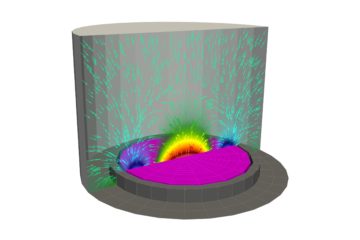Numerical simulations of vacuum pumps can be utilized to predict the pumping performance of new concepts and optimize existing products without the need for expensive experimental campaigns and prototypes. Molecular drag pumps are one of several vacuum pump technologies that are available on the market. The application case presented in the following is investigated with the Direct Simulation Monte Carlo (DSMC) method within PICLas.
Mesh discretization & setup
The setup is a single stage helical-type (Holweck) molecular drag pump in the transitional flow regime. The rotor has a diameter of 169 mm and a height of 41 mm. The simulation domain extends 11 mm below (outlet) and 5mm above the rotor (inlet). The clearance to the outer stator cylinder is 0.5 mm. The number of grooves is six, allowing to exploit rotational symmetry with a 60° slice. The discretized geometry is shown on the left.
The simulation is performed in the rotational frame of reference with diatomic nitrogen as the test gas. The boundary conditions are defined by an outlet pressure of 30.3 Pascal and a constant mass flow of 66 sccm. The rotational speed of the rotor are 24,000 rounds per minute. A simulation result is shown in terms of the surface pressure on the rotor in the figure below.
Comparison with experimental measurements
The experimental measurements from the literature have been performed by Kim et al. (2008) at five different points along the outer cylinder height. The pressure measurements are compared to the simulation results, where good agreement can be observed. Thus, predictive simulations can be performed to investigate new concepts and gain detailed insights into the pumping mechanisms in the transitional flow regime. Besides a single, helical-type stage, it is possible to simulate a disk-type molecular drag pump (Siegbahn) as well as multiple stages within a turbomolecular pump with PICLas.
More information about the experimental setup and measurements can be found here:
- Kim, D.-H., Kwon, M.-K., Hwang, Y.-K., & Abe, T. (2009). A Study on the Pumping Performance of a Helical-type Molecular Drag Pump. AIP Conference Proceedings 1141–1146.



